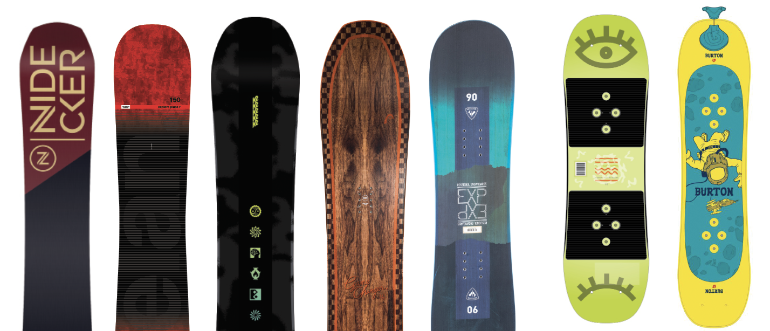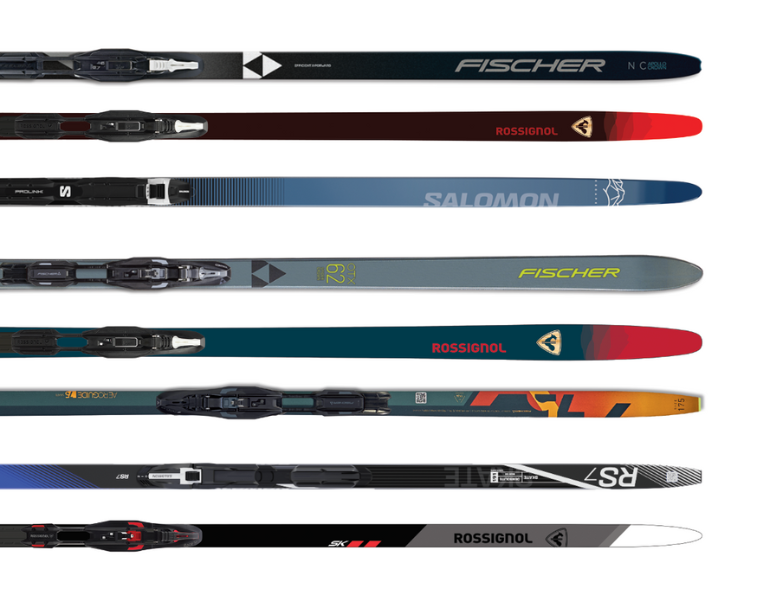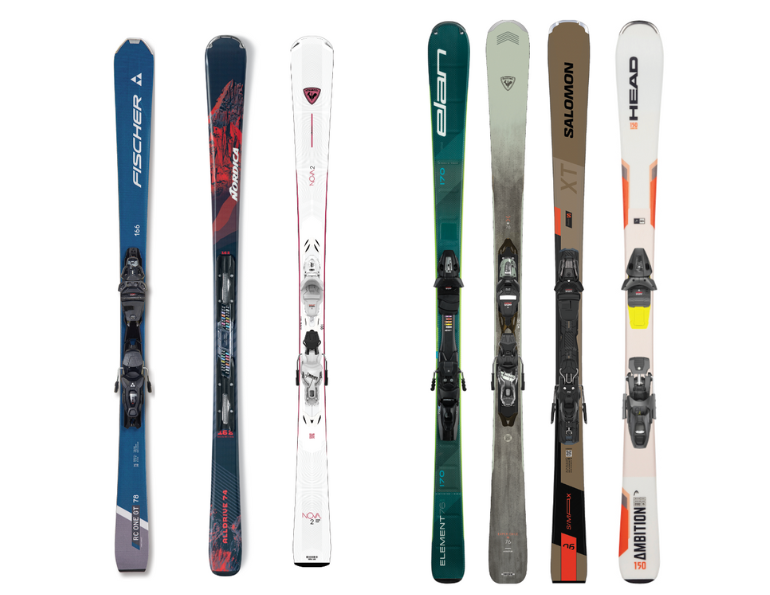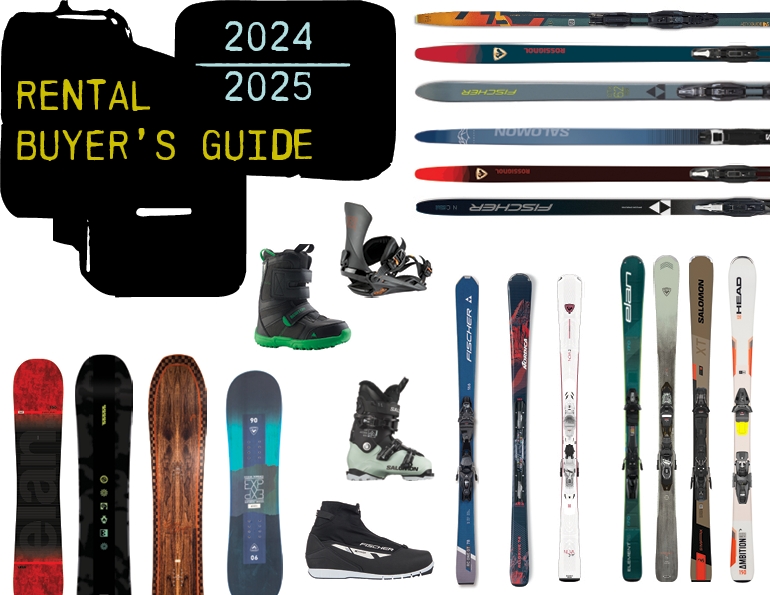Alpine Ski Rental
Plus ça change, plus c’est la même chose. After three years of upheaval on the world stage, some sense of normalcy is back in the alpine rental market. Covid, the war in Ukraine, supply chain disruptions, etc., aren’t completely in the rearview mirror, but they are now having only a minimal impact on the rental business.
Good news. Even post-Covid price increases appear to have mellowed, thanks to a favorable U.S. dollar-euro exchange rate and stabilized shipping costs. Kurt Hoefler of Rossignol, Scott Ford of Fischer, and Rob McCutcheon of Elan agree that shipping costs have stabilized, and that is reflected in minimal rental price increases for the coming buying season.
Last year, most equipment suppliers reported a notable spike in rental sales. That was largely a follow-up response to buyers postponing purchases for the 2020-21 season, which then helped to create a bottleneck in order fulfillment and delivery for 2021-22. Heading into 2024, Fischer’s Ford reports that “delivery and movement of equipment is as good as it’s ever been,” a sentiment echoed by other company reps. Nordica’s Ethan Korpi reported that 98 percent of Nordica’s rental products were delivered by mid-November.
La même chose is the theme when it comes to rental R&D. For the most part, last year’s rental catalogs could pass for this year’s, with minor tweaks (e.g., new top sheets and graphics).
Filling the middle. One continuing trend is a broadening of the typical rental fleet toward what Rossignol’s Jake Stevens calls a “more diverse buy.” Rental buyers are increasingly filling in the gap between basic fleet-rental gear and demo equipment. “There has absolutely been a shift toward medium-performance, medium-width skis,” says Elan’s McCutcheon.
Adds Nordica’s Korpi: “[Rental buys] are definitely shifting toward a middle- and higher-end tranche, a trend that didn’t exist 10 years ago.” He adds that the rental market is “evolving and getting more complicated, covering daily, long-term, weekly, and even seasonal customers.” Thus, a modern-day rental fleet might consist of two to four tiers of ski and boot models. Throw in the growing number of women-specific models in both boots and skis, and the options grow further.
Skis
At the entry level are skis like Rossignol’s EXP 76, Elan’s Element 76, and Head’s Ambition R. These models are aimed primarily at high-volume weekend resorts and are typically packaged in a systems set-up, with Head’s three-sole-length BYS system, Rossi’s four-sole-length Flash system, and Elan-Alpina’s 4Factor system continuing to be the main players.
These products are aimed at budget-conscious and high-volume buyers, but company reps insist that they pack solid performance punch at a minimal price. “We want to build a ski that lasts and delivers a good experience,” says Mayhew of Head’s entry-level offering. Says Fischer’s Ford: “The first price-point product is really improving.”
Nevertheless, a little more money can buy a better product. “It’s not a huge difference in the step-up cost,” says Rossi’s Hoefler, meaning less than 10 percent to buy up to the next performance level. “With one rental, you’ve made your money back.”
Speed vs. step-up. Plus, not every resort needs, or wants, a system solution. At resorts where many rental packages are now pre-ordered online—and hence gear can be prepped before guest arrival—or at a destination resort where the morning rush is not so pronounced, the speed of a systems approach is not so important. Stepping up slightly to better-performing gear can also accentuate a better overall guest experience.
Models at the next performance level include Elan’s new Element RS 78, featuring its groove/wave motion technology that makes for an easier flex but with added torsional stiffness, and Rossignol’s wood-core Experience lineup, offered in various widths and with men’s and women’s models. Head’s wood-core Shape AM—with a corresponding Joy series for women—features a bit more shape in the tail, and, at 80 mm at the waist, is what Mayhew calls more of a Western model.
Some companies, like Nordica and Völkl, eschew the entry-level tier altogether. Nordica’s step-up models include the Alldrive 74, aimed primarily at Eastern resorts, and the wider Alldrive 84, with what Korpi calls “an oversized shovel.” Fischer’s XTR RC One GT 78 and GT 82 are designed with a “triple-radius” dimension to facilitate various turn shapes. Salomon’s entries in this category are the S/Max 06 XT and S/Max 08 XT, with 76 mm and 80 mm waists, respectively.
Taking one more step up the performance ladder, Rossignol is matching its Forza carving models, introduced last year, with the new women’s-specific Nova line. Head matches its Kore X models with its women-specific Joy series.
Moving up from there means moving into demo territory, where all suppliers have a fairly wide-ranging lineup of in-line models, usually (though not always) modified for rental with tougher topsheets and sidewalls. This is a growing category driven by an increase in destination travelers, company reps say.
One performance trend affects nearly all rental models: the near-total move from extruded bases to sintered bases. Sintered bases offer greater durability as well as an increased ability to hold wax, meaning better glide and better performance. Similarly, most rental bindings are now GripWalk compatible.
Boots
A well-fitting, comfortable boot is the most essential component of a good rental experience. Given the wide variety of skiing abilities and foot shapes, rental offerings in boots are becoming perhaps more vertically integrated than in skis.
A common boot lineup from any of the major rental suppliers consists of three or four performance tiers, with lasts from 104 mm to 100 mm and flex values ranging from 85 to 110. A typical example might be Rossignol’s basic four-boot (non-Flash) lineup, from the 104 mm Evo Rental to the 100 mm Hi-Speed Pro MV Rental, with four corresponding women’s models, from the Kelia Rental to the Pure Pro Rental.
BOA comes to rentals. The BOA adjustment system has hit the ski boot world and is beginning to infiltrate rental lineups. BOA hasn’t yet reached down into the lower price tiers, but both Fischer (with its RC4 95 MV BOA) and Salomon (with its S Pro Supra BOA) offer BOA in higher-performance models. A trickle-down of BOA technology into lower price points is likely in the future.
Nordica’s rear-entry HF grouping is a retro technology of sorts. While this easy-entry design used to be associated with big-bucket, squishy designs for low-level skiers, Nordica’s Korpi notes that the HF line offers more performance, including the HF Pro with a 100 mm last and a 110 flex, a pretty beefy boot.
Another ease-of-use design is Salomon’s QST Access boot, with a lever in the back to allow loosening between the cuff and the lower for easier walking.
In sum, “stable” describes the current alpine rental market. Stable pricing, stable delivery, stable product design, stable market conditions. The more things have changed, the more they have stayed the same.
Snowboard Rental
By Annie Fast
Overall, snowboard brands see room for growth in rental operations.
Rossignol sales and marketing VP Kurt Hoefler says, “Before Covid we saw a tapering of rental snowboards, then we started to see growth during Covid, and now there is a resurgence.” He attributes this growth to new people entering snowboarding, particularly younger people.
Burton merchandising manager Chris DiMarco says, “We saw amazing participation growth out of this season’s NSAA Participation report.” He sees rentals as an opportunity to grow the sport, saying, “Often, renting is a person’s first time snowboarding. The easier and more comfortable we can make that experience, the better our chances are at adding another lifetime snowboarder.”
Brian Hankerson, rider services coordinator for Nidecker, attributes growth to “multi-mountain season passes and this segments’ use of rentals.” At the same time, he adds, “One of the largest challenges facing the snowboard community as a whole is the decline of brick-and-mortar shops.” He sees rental programs as an important means to create relationships with new riders that will keep them coming back.
Nitro also sees opportunity in rental programs, and brought on Adam Stromwall in a new role as the U.S.-based rental sales coordinator earlier this year.
Ben Fresco, product and marketing director at Elan, sees opportunity with travelers who are opting not to travel with gear. “Baggage fees aren’t getting any less expensive, so visitors are more inclined to rent or demo when they travel,” he says. “This makes a well-rounded demo and rental collection more important than ever.”
 Left to right: Nidecker Axis; Elan Explore Plus R; K2 Embassy Rental; Head Gamechanger 4D; Rossignol EXP Junior; Burton kids 70 cm rental board and kids Riglet board.
Left to right: Nidecker Axis; Elan Explore Plus R; K2 Embassy Rental; Head Gamechanger 4D; Rossignol EXP Junior; Burton kids 70 cm rental board and kids Riglet board.
 TOP, left to right: Burton Kids Rental Step On boot and Kids Progression boot; Nitro Access youth boot. BOTTOM, left to right: Burton Step On binding; Nitro Team Rental Pro; Nidecker Rental boot.
TOP, left to right: Burton Kids Rental Step On boot and Kids Progression boot; Nitro Access youth boot. BOTTOM, left to right: Burton Step On binding; Nitro Team Rental Pro; Nidecker Rental boot.
2024-25 Trends
The youth category is growing. Rossignol is now offering its EXP Junior youth snowboard in a 70 cm length; previously 80 cm was the smallest. Hoefler says this is in response to demands from ride schools. He says, “We’re seeing younger and younger kids, and this board sizing specifically meets that demand.”
Burton also offers a 70 cm kids rental board, as well as the kids Riglet board and Handlebar for even younger riders. The Burton Kids Progression boot in XXS fits sizes 7C-10C, with the Kids Rental Step On boot offered down to a size 3 “for now,” says DiMarco, hinting at plans for even smaller sizing in the future.
BOA is big. BOA is widely available across adult rental lines. K2, Burton, and Nidecker offer it exclusively on their rental boots. Head is primarily focused on BOA, with one lace option to meet persistent demand. Rossignol offers BOA or lace options on its EXP series boots. Nitro enters the market with four different lacing options, including BOA.
Durability and efficiency rule. Rental snowboard lines continue to feature durable top sheets and edges. These pair with color coding, bar coding, and tool-free binding mounting and adjustment systems designed to speed up the customer experience and streamline employee training. Ease of use, for both rental staff and guests, remains a key goal.
Head’s Marshall Mayhew sums up the approach: “We make sure the product is easy to use for both consumers and technicians using the three design principles of usability, durability, and system integration to deliver a good experience.”
Here’s a look at what some key players are doing:
BURTON: Step On Momentum. Burton is broadening its rollout of its Step On system, first introduced for 2023-24. “Step On provides the best possible customer experience in the rental environment, especially for those first coming to the sport,” says DiMarco. The Step On system is offered in the full range of men’s, women’s, and kid’s sizing down to 3K. Burton also continues to offer its traditional Progression boot and binding system as well as the LTR family, which is now simply called “Rental.”
The brand is also continuing its online rental program, which it rolled out last season. Renters can rent boards, boots, bindings, and outerwear, shipped to their home, hotel, or any UPS location in the continental U.S. “Those learnings are helping to educate our path forward with rentals,” DiMarco says.
ROSSIGNOL: Updated EXP Line. Rossignol has completely updated the fleet-oriented EXP snowboard line with a snub-nosed tip and tail, more premium graphics, and simplified sizing (every 5 cm or 10 cm) in 20 sizes and four widths. The range includes the addition of a 70 cm youth size. The EXP3 Rail Series, introduced last season, streamlines the fitting/sizing of bindings and helps guests get on snow faster. Rossignol has also streamlined its rental bindings; just two sizes accommodate the whole range of adult boot sizing. “We’re trying to increase speed and setup for the customer—alpine is fast and efficient, snowboarding is not,” says Hoefler. Rossi also introduced a new rental boot in 2023-24, which carries over this year.
HEAD: Expanding Lines. Head is adding a new premium snowboard, the Gamechanger 4D, which Mayhew positions as a “second price point, demo sport package board.” The Gamechanger features a snub-shaped tip and tail with a hybrid camber and complements the Flex and Flaka fleet lines. Head also filled in its youth rental line with the new Lyrent 4D Jr. binding, with new junior color coding that allows “seamlessness between adult and kids sizes,” Mayhew says. Head continues to offer the upgraded FutureDisc mounting system (introduced in 2023-24 season as an update to the compatible SpeedDisc system), which simplifies the mounting process for employees and speeds up the renting process for customers.
NITRO: In-Line Look. Nitro aims to offer rental boards, boots, and bindings that are durable and functional but also look and feel like regular retail products. “We strive to offer not just entry-level boards, but also more advanced and some specialized models,” Nitro co-founder and president Tommy Delago says, such as park boards and rental-specific powder shapes. Nitro is offering two tiers of unisex boots, the Agent and the Rise, as well as the Access youth boot, plus a rental version of the best-selling in-line Team binding as the Team Rental Pro.
ELAN: Focus on Service. Elan’s snowboard rental line is unchanged for 2024-25. It consists of the Explore R and Explore Plus R snowboard lines (jib rocker versus all-terrain rocker), two Explore Junior board models, with one Rental boot offered in a size range of men’s 2–15, and accompanying bindings. Fresco says the brand is creating a new position dedicated to maintaining relationships with rental clients and serving their needs.
NIDECKER: Ease and Durability. Nidecker is making no changes to its rental program; it redesigned its rental boot for 2023-24. Hankerson says, “Our main focus with our rental options is to make things as easy and durable as possible. We want our customers to spend less time dealing with equipment and more time enjoying the thrill of snowboarding.” This ease includes the Easy Lock disc mounting system for bindings. Durability on the boards comes from rubberized tips and tails.
K2: New and Updated. K2 Snowboarding is introducing a redesigned binding, a new board, and updated boots to its dedicated rental lineup. Elevate Outdoor Collective global product line manager Megan Stark says, “Our team is most excited with the newly redesigned SR1 snowboard rental binding.” The SR1 features all-new toolless engagement and clip-discs to speed the setup process. The all-new Embassy Rental snowboard, built for the advanced to expert rider, comes with inline graphic design and key durability upgrades, including integrated carbon fiber stringers, a scratch-resistant top sheet, and extruded base. It joins the Gateway and Dreamsicle Rental in K2’s rental snowboard line. The Maysis, Raider, Vandal, and Haven boots have been updated to decrease wear and increase durability.
Cross-Country Rental
By Peter Oliver
The surge in interest in cross-country skiing spurred by the arrival of Covid in 2020 appears to have crested, and for rental buyers, that might actually be a good thing. For at least a couple of buying cycles, inventory was hard to come by. That’s no longer true.
Overall, cross-country is receding a bit,” says Cross Country Ski Areas Association executive director Reese Brown. “Suppliers are finally catching up. For the first time in three years, they can refill orders.” Fischer’s Steve Reeder agrees. “Things have normalized in the supply chain,” he says. “We now have re-order capability.”
For the most part, assembling a cross-country rental lineup is basically a matter of picking and choosing from a company’s retail catalog, after which suppliers apply a volume discount for rental buyers. According to Rossignol’s Kurt Hoefler, the company’s typical rental discount is 22 percent off the wholesale price.
 Top to bottom, classic skis: Fischer Apollo; Rossig- nol XT 55; Salomon Escape Snow 59; Fischer Spider OT 62; Rossignol EVO OT 65. Skate skis: Fischer Aeroguide 75; Salomon RS7; Rossignol Delta Sport.
Top to bottom, classic skis: Fischer Apollo; Rossig- nol XT 55; Salomon Escape Snow 59; Fischer Spider OT 62; Rossignol EVO OT 65. Skate skis: Fischer Aeroguide 75; Salomon RS7; Rossignol Delta Sport.
Skis
The “go-to workhorse” in Rossi’s touring package, says Hoefler, is the XT 55 ski; Reeder says that Fischer’s 50 mm Apollo and the 60 mm Voyager are the most popular rental touring choices. The XT 55, the Apollo, and the Voyager all come in somewhat shorter lengths and wider sidecuts than performance skis to provide more control and maneuverability for less experienced skiers. The Salomon Escape Snow 59, which comes in five lengths (unlike Fischer’s and Rossignol’s four-length approach) is probably the brand’s best rental option.
There have been relatively few technological advances in cross country gear in recent years. One exception: underfoot skin “pockets,” instead of textured surfaces, for waxless kicking. However, Reeder points out that “mechanical” bases (textured or fish-scale-like surfaces) still have a wider range of utility and require less maintenance, making them a smart choice for fleet use.
Brown reports that he has seen a “bump in skate gear,” perhaps a signal to rental buyers to expand their skate fleets. For skate skis, Reeder recommends Fischer’s new Aeroguide 75 (or the next-level Aeroguide 85), which he characterizes as “more stable and easier to push” than an advanced skate ski. Rossignol counters with the Delta Sport, the least pricey of its three Delta models. Salomon offers its RS7, which also comes in a stiff version.
Off-track skis. Reeder says that he has seen “huge interest in the off-track category.” If there is lots of off-track (ungroomed) terrain nearby to explore, a rental investment in wider skis and beefier boots might make sense. Rossi’s Evo OT 60 or Evo OT 65, both of which are still narrow enough to fit into groomed, set tracks and have a partial metal edge underfoot, might be a sensible option. A comparable Fischer model is the Spider 62, designed for on- and off-track versatility, with a full metal edge.
 Left to right: Fischer XTR RC One GT 78; Nordica Alldrive 74; Rossignol women’s-specific Nova line; Elan Element 76; Rossignol EXP 76; Salomon S/MAX 06 XT; Head Ambition R.
Left to right: Fischer XTR RC One GT 78; Nordica Alldrive 74; Rossignol women’s-specific Nova line; Elan Element 76; Rossignol EXP 76; Salomon S/MAX 06 XT; Head Ambition R.
 Left to right: Nordica rear-entry HF Pro BOA; Rossignol women’s Pure Pro; Salomon QST Access with walk mode; Fischer RC4 95 MV BOA.
Left to right: Nordica rear-entry HF Pro BOA; Rossignol women’s Pure Pro; Salomon QST Access with walk mode; Fischer RC4 95 MV BOA.
Boots
When it comes to boots, the main options are touring or combi boots. Even in classic mode, combi boots are often popular with rental customers because of the extra ankle support they provide.
Hoefler says that Rossignol’s most popular rental model is the X2, a touring boot with a little more support than the budget-priced, rental-specific X1. However, neither the X1 nor the X2 can really double as a skate boot. Buyers seeking such a combi boot can jump up the price ladder to a higher-cuffed X5, X6, or X8.
Fischer’s XC Power for classic skiing comes with a sole that makes for easier walking, says Reeder, and it also “transfers power really well.” For a combi boot, Reeder says that the Control has been improved with a higher and stiffer cuff.






